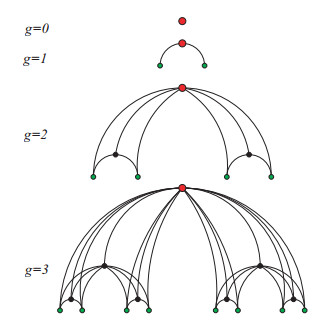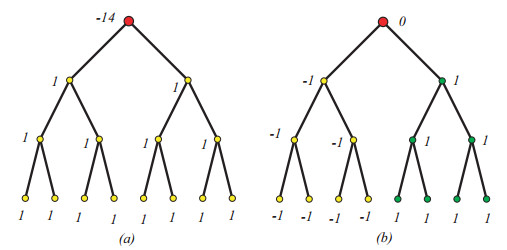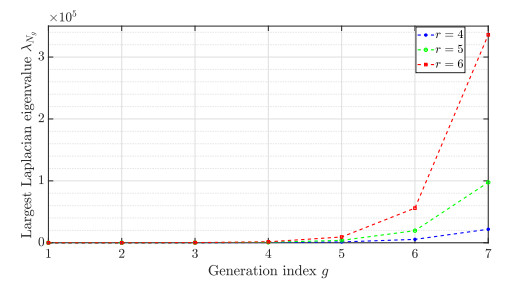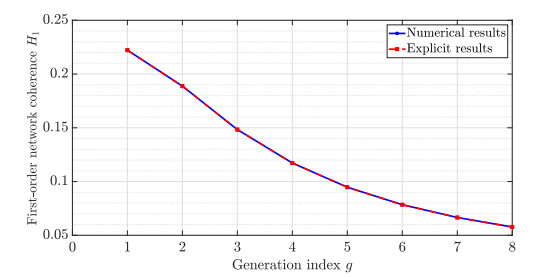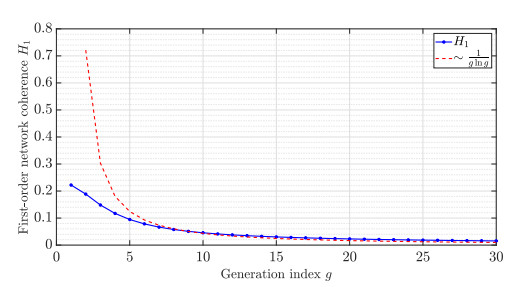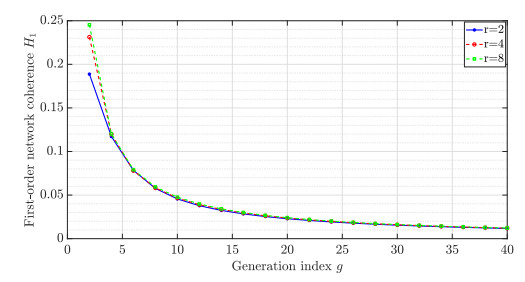1.
Introduction
The consensus problem has been primarily investigated in management science, and statistics [1,2,3]. Nowadays, it has become a challenging and hot research area for multiagent systems [4,5,6]. In these settings, consensus means that all agents reach an agreement on one common issue. Consensus problems have emerged in various disciplines, such as graph decision making [7,8], distributed computing [9], sensor networks [10,11], biological systems [12,13], and human group dynamics [14]. Due to their broad applications, consensus problems have attracted considerable attention in recent years [15,16,17,18,19,20,21].
Convergence speed, communication time-delay robustness, and network coherence are the three primary aspects of the consensus protocol. Convergence speed measures the time of convergence of the consensus algorithm. It has been proved that convergence speed is determined by the second smallest Laplacian eigenvalue λ2 [4,22]. Communication time-delay robustness refers to the ability of the consensus algorithm to resist against communication delay between agents [23,24], with the maximum delay allowable being determined by the largest Laplacian eigenvalue λN [4,22]. Network coherence quantifies the robustness of the consensus algorithm against stochastic external disturbances, and it is governed by all nonzero Laplacian eigenvalues [22,25]. As we all know, λ2(G)≥λ2(H) when H is a spanning subgraph of G [26,27]. It means that adding edges to a graph may increase its second smallest Laplacian eigenvalue. Zelazo et al. [28] provided an analytic characterization of how the addition of edges improves the convergence speed. It is well-known that Δ+1≤λN≤2Δ, where Δ is the maximum vertex degree [26]. Wu and Guan [29] found that we can improve the robustness to time-delay by deleting some edges linking the vertices with the maximum degree. As for network coherence, Summers et al. [30] considered how to optimize coherence by adding some selected edges. Recently, network coherence on deterministic networks has become a new focus. Previously studied networks include ring, path [31], star, complete graph, torus graph [25], fractal tree-like graph [5,32], Farey graph [33], web graph [34], recursive trees [35,36], Koch network [37], hierarchical graph, Sierpinski graph [22], weighted Koch network [38], windmill-type graphs [15], 4-clique motif network, and pseudofractal scale-free web [39]. Among all these graphs, the complete graph presents optimal structure and the best performance for noisy consensus dynamics. However, the complete graph is a dense graph, resulting in high communication costs. In the real-world, it has been shown that networks are often sparse, small-world, and scale-free. As such, Yi et al. [39] asked two open questions: What is the minimum scaling of the first-order coherence for sparse networks? Is this minimal scaling achieved in real scale-free networks? We will give a positive answer to these two questions in this paper.
Another interesting question about network coherence is how network structural characteristics affect network coherence [22,33,39]. It has been shown that the scale-free behavior and the small-world topology can significantly improve network coherence [33,39]. Clearly, the star [31] cannot be small-world for its small clustering coefficient. But the first-order coherence of a large star will converge to a small constant. The pseudofractal scale-free web [40] and the Farey graph [41] are two famous small-world networks with high clustering coefficient. However, the scale of the first-order coherence on the Farey graph is much larger than that on the pseudofractal scale-free web [22,33]. So, some other network structural characteristics can affect the first-order coherence. Yi et al. [22] pointed to the scale-free behavior, which is absent on the Farey graph. However, the Koch network [42] is small-world and scale-free, and the first-order coherence on the Koch network scales with the order of the network. In addition, it is clear that the complete graph and the star are not scale-free, but the first-order coherence on these two graphs are very small. As a result, something else can affect the network coherence. In this paper, by analyzing and comparing several studied networks, we will give our answer to the above question.
The outline of this work is as follows: In Section 2, we present some notations and definitions in graph theory and consensus problems. In Section 3, we construct the hierarchical small-world network. In Section 4, we compute the Laplacian eigenvalues and the network coherence. In Section 5, we make a conclusion.
2.
Preliminaries
Let G=(V,E) be a connected and undirected graph (network). |S| denotes the cardinality of the set S. The order (number of vertices) and the size (number of edges) of G are n=|V| and m=|E|, respectively. If e={u,v} is an edge of G, we say vertices u,v are adjacent by e, and u is a neighbor of v. Let NG(v) denote the set of neighbors of v in graph G. The degree of vertex v in graph G is given by dG(v)=|NG(v)|. We denote the maximum and minimum vertex degrees of G by Δ and δ, respectively. Let S be a subset of vertex set V. G−S is the graph obtained from G by deleting all vertices in S. If G−S is disconnected, we call S a vertex cut set of G. The vertex connectivity cv of graph G is defined as the minimum order of all vertex cut sets. Similarly, we can define the edge connectivity ce.
The density of graph G is given by [43]
Clearly, 0≤d≤1. G is a sparse graph if and only if d≪1.
In order to improve readability and help the readers follow the derivations more easily, we list all frequently used symbols in Table 1.
2.1. Key graph matrices
The adjacency matrix of graph G is a symmetric matrix A=A(G)=[ai,j], whose (i,j)-entry is
The degree matrix of graph G is a diagonal matrix D=D(G)=[di,j] where
The Laplacian matrix of graph G is defined by L=D−A. X is a column vector of order n. We write (LX)i as the element corresponding to the vertex vi in the vector LX.
Theorem 2.1. [26,27] Let G be a connected and undirected graph with vertex set V(G)={v1,v2,⋯,vn}. X=(x1,x2,⋯,xn)⊤ is a column vector. Then the following assertions hold.
(i) LX=λX if and only if, for each i,
(ii) The rank of L is N−1.
(iii) The row (column) sum of L is zero.
According to (iii), we know that 0 is an eigenvalue of L with corresponding eigenvector 1=(1,1,⋯,1)⊤. Since the rank of L is n−1, we can write the eigenvalues of L as 0=λ1<λ2≤λ3≤⋯≤λn. The second smallest Laplacian eigenvalue λ2 is called the algebraic connectivity of the graph. This concept was introduced by Fiedler [44]. A classical result on the bounds for λ2 is given by Fiedler [44] as follows:
We call the largest eigenvalue λN the Laplacian spectral radius of the graph G.
Lemma 2.2. [45] Let G be a connected graph on n vertices with at least one edge, then λn≥Δ+1, where Δ is the maximum degree of the graph G, with equality if and only if Δ=n−1.
The transition matrix of graph G is a N-order matrix P=[pi,j] in which pij=ai,jdG(vi). So P=D−1A. Since P is conjugate to the symmetric matrix D−12AD−12, all eigenvalues of P are real. We denote these eigenvalues as 1=θ1>θ2≥⋯≥θN.
2.2. Consensus problems
In this subsection, we give a simple introduction from a graph theory perspective to consensus problems [5,22]. We refer the readers to references [4,5,22,25] for more details. The information exchange network of a multiagent system can be modeled via graph G. Each vertex of graph G represents an agent, and each edge of graph G represents a communication channel. Two endpoints of an edge can exchange information with each other through the communication channel. Usually, the state of the system at time t is given by a column vector X(t)=(x1(t),x2(t),⋯,xn(t))⊤∈Rn, where xi(t) denotes the state (e.g., position, velocity, temperature) of the agent vi at time t. Each agent can update its state according to its current state and the information received from its neighbors. Generally, the dynamic of each agent vi can be described by ˙xi(t)=ui(t), where ui(t) is the consensus protocol (or algorithm).
2.2.1. Consensus without communication time-delay and noise
Olfati-Saber and Murray [4] proved that if
then, the state vector X(t) evolves according to the following differential equation:
and asymptotically converges to the average of the initial states (i.e., for each i, limt→∞xi(t)=1n∑nk=1xk(0), where xk(0) is the initial state of agent vk). This means that the system with protocol (2.4) can reach an average-consensus. In addition, the convergence speed of X(t) can be measured by the second smallest Laplacian eigenvalue λ2 [4], i.e.,
Thus, the larger the value of λ2, the faster the convergence speed [22].
2.2.2. Consensus with communication time-delay
There are some finite time lags for agents to communicate with each other in many real-world networks. Olfati-Saber and Murray [4] showed that if the time delay for all pairs of agents is independent on t and fixed to a small constant ϵ,
then, the state vector X(t) evolves according to the following delay differential equation:
In addition, X(t) asymptotically converges to the average of the initial states if and only if ϵ satisfies the following condition:
Eq (2.9) shows that the largest Laplacian eigenvalue λn is a good measure for delay robustness: The smaller the value of λn, the bigger the maximum delay ϵmax [22]. Moreover, similarly to the system with protocol (2.4), the convergence speed of the system with protocol (2.7) is also determined by the second smallest Laplacian eigenvalue λ2 [4,22].
2.2.3. Consensus with white noise
In order to capture the robustness of consensus algorithms when the agents are subject to external perturbations, Patterson and Bamieh [5] introduced a new quantity called network coherence.
First-order network coherence: In the first-order consensus problem, each agent has a single state xi(t). The dynamics of this system are given by [5,22,25]
where w(t)∈Rn is the white noise.
It is interesting that if the noise w(t) satisfies some particular conditions, the state of each agent xi(t) does not necessarily converge to the average-consensus, but fluctuates around the average of the current states [5,22]. The variance of these fluctuations can be captured by network coherence.
Definition 2.3. (Definition 2.1 of [5]) For a connected graph G, the first-order network coherence H1 is defined as the mean (over all vertices), steady-state variance of the deviation from the average of the current agents states,
where var{⋅} denotes the variance.
It is amazing for algebraic graph theorists that H1 is completely determined by the N−1 nonzero Laplacian eigenvalues [25]. Specifically, the first-order network coherence equals
Lower H1 implies better robustness of the system irrespective of the presence of noise, i.e., vertices remain closer to consensus at the average of their current states [5,22].
3.
Network construction and properties
The hierarchical small-world network was introduced by Chen et al. [46] and can be created following a recursive-modular method, see Figure 1. Let Mrg(g≥0,r≥2) denote the network after g generations of evolution. For g=0, the network M0 is a single vertex. For g≥1, Mrg can be obtained from r copies of Mrg−1 and a new vertex by linking the new vertex to every vertex in each copy of Mrg−1.
Remark: From Figure 1, it is easy to see that the network is self-similar. The self-similarity is a common property of deterministic networks [47], which promises to advance our understanding of the way complex networks behave and grow.
A rooted tree T is a tree with a particular vertex v0, see Figure 2. We call v0 the root of T. Let v be a vertex of T. If v has only one neighbor, v is a leaf of T; if v has at least two neighbors, v is a non-leaf vetex of T. The level of vertex v in T is the length of the unique path from v0 to v. Note that the level of the root v0 is 0. The height of rooted tree T is the largest level number of all vertices. We always use a directed tree to describe a rooted tree by replacing each edge with an arc (directed edge) directing from a vertex of level i to a vertex of level i+1. Figure 2 shows a root tree of height 3.
If (u,v) is an arc of the rooted tree T, then u is the parent of v, and v is a child of u. If there is a unique directed path from a vertex v to a vertex w, we say that v is an ancestor of w, and w is a descendant of v. For r≥2, a rooted tree is called a full r-ary tree if all leaves are in the same level and every non-leaf vertex has exactly r children. The rooted tree illustrated in Figure 2 is a full 2-ary (binary) tree. The r-ary tree is one of the most important data structures in computer science [48,49] and mathematics [50,51,52]. It is not difficult to see that the hierarchical network Mrg can also be obtained from a rooted tree Tg of height g by linking every non-leaf vertex to all its descendants, and we call the rooted tree Tg the basic tree of Mrg.
Let Ng and Eg denote the order and size of the hierarchical small-world network Mrg, respectively. According to the two construction algorithms, we have
and
According to Eq (2.1), the density of Mrg is given by
If Ng≫1, then g+1(r−1)Ng(Ng−1)→0 and also g−1r−1Ng−1≪1, that is d≪1. Hence, the hierarchical small-world network Mrg is a sparse network.
In an arbitrary level i of the basic tree Tg, there are ri vertices. We randomly choose a vertex v. The probability that it comes from level i is
Since all vertices in level i have the same degree ki=rg+1−i−1r−1+i−1, and vertices in different levels have different degrees, the degree distribution P(k) of the hierarchical small-world network is
The degree distribution of a real-world network always follows a power-law distribution P(k)∼k−γ with γ>1 [53]. For the hierarchical small-world network, according to the result in [46], we know that γ would approach 1 when Mrg is large enough. That is abnormal. However, this network model exists in real life since it is a good model for the benefit transmission web of the pyramid scheme [54] in China and many other countries.
4.
Calculations of network coherence
4.1. Eigenvalues and their corresponding eigenvectors
Let Tg be the basic tree of Mrg and V(Tg)=V(Mrg)={v0,v1,⋯,vNg−1}. The root of Tg is v0. For each vertex vi∈Tg, we denote the set of descendants (ancestors) of vi by des(vi)(anc(vi)). Let Di=|des(vi)| and Ai=|anc(vi)|. Let dg(vi) be the degree of vi in Mrg. It is important to note that dg(vi)=Di+Ai for each i. Let lg(vi) denote the level of vi in Tg. It is not difficult to see that lg(vi)=Ai.
In order to help the readers to get a direct impression of the following theorem and a better understanding of the proof, we introduce an example.
Example 4.1. As shown in Figure 2, root v0 is a non-leaf vertex of the basic tree T3, and d3(v0)=14,l3(v0)=0. v1 is the left child of root v0. Let α=d3(v0)+1=15, β=l3(v0)+1=1. Then α is a Laplacian eigenvalue of M23 with the corresponding eigenvector X shown in Figure 3(a), because Eq (2.2) holds for every vertex of M23. For instance, equations (LX)0=14⋅(−14)−1⋅14=15⋅(−14)=αx0 and (LX)1=7⋅1+14−6⋅1=15⋅1=α⋅x1 show that Eq. (2.2) holds for root v0 and vertex v1, respectively. Similarly, β is also a Laplacian eigenvalue of M23 with the corresponding eigenvector X′ shown in Figure 3(b). For instance, equations (LX′)0=0+7⋅1−7⋅1=0=βx′0 and (LX′)1=7⋅(−1)+6⋅1=−1=βx′1 verify that Eq (2.2) holds for root v0 and vertex v1, respectively.
Theorem 4.2. The nonzero Laplacian eigenvalues of the hierarchical small-world network Mrg are the following:
1. dg(vi)+1, repeated exactly once for each non-leaf vertex vi;
2. lg(vi)+1, repeated r−1 times for each non-leaf vertex vi.
Proof. Let Lg be the Laplacian matrix of Mrg. As mentioned above, 0 is a special eigenvalue of Lg with corresponding eigenvector 1Ng=(1,1,⋯,1)⊤. Since Mrg is connected, Lg has Ng−1 non-zero eigenvalues. It is clear that, in the full r-ary tree Tg, each vertex of level g is a leaf, and each vertex of level i(i≤g−1) is a non-leaf vertex. Thus, Tg has rg−1r−1 non-leaf vertices. So the total number of eigenvalues mentioned in the statement of this theorem add up to rg−1r−1⋅r=rg+1−rr−1, which equals Ng−1.
Case 1: When λg=dg(vi)+1, where vi is a non-leaf vertex in Tg.
Let Xg=(x0,x1,⋯,xNg−1)⊤ be a column vector, and
Since the number of descendants of vi is just Di, we have ∑Ngj=1xj=1⋅Di−Di−0=0. Then, Xg is orthogonal to the vector 1Ng. We now have to prove that Xg is indeed an eigenvector corresponding to the given eigenvalue λg=dg(vi)+1. In the proof, our main tool is Eq (2.2).
For the vertex vi, xi=−Di. xj=1 if vj is a descendant of vi; xj=0 if vj is an ancestor of vi. Thus, we have
For the vertex vk, which is an ancestor of vi, xk=0. xj=−Di if vj is vi; xj=1 if vj is a descendant of vi; xj=0 if vj is one of other neighbors of vk. Hence, we have
For the vertex vk, which is a descendant of vi, xk=1. xj=−Di if vj is vi; xj=1 if vj is a descendant of vk; xj=1 if vj is a ancestor of vk and also a descendant of vi; xj=0 if vj is one of other neighbors of vk. It is important to note that the number of ancestors of vk, which are also descendants of vi, is Ak−Ai−1, i.e., |anc(vk)∩des(vi)|=Ak−Ai−1. We minus 1 here because vertex vi is not a descendant of itself, so it should be removed. Also, dg(vk)=Dk+Ak and dg(vi)=Di+Ai. Then, we have
It is clear that the equation (LgXg)k=(λgXg)k holds for all other vertices. Therefore, we have proved LgXg=λgXg.
Case 2: When λg=lg(vi)+1 where vi is a non-leaf vertex in Tg.
We denote the r children of vi by c1,c2,⋯,cr. For each t∈{1,2,⋯,r}, let Ft=ct∪des(ct). Let |F1|=f. Since Tg is a full r-ary tree, we have |Ft|=f for every t∈{1,2,⋯,r}. For each s∈{2,3,⋯,r}, let Xsg=(xs0,,xs1,⋯,xsNg−1)⊤ be a column vector, and
Since |Fs|=|F1|=f, ∑Ngj=1xsj=f⋅1+f⋅(−1)−0=0. Hence, Xsg is orthogonal to the vector 1Ng. We now have to prove that Xsg is indeed an eigenvector corresponding to the given eigenvalue λg=lg(vi)+1.
For the vertex vk, which is an ancestor of c1, xsk=0. xsj=−1 if vj∈F1; xsj=1 if vj∈Fs; xsj=0 if vj is one of the other neighbors of vk. According to Eq (2.2), we have
For the vertex vk∈F1, xsk=−1. xsj=−1 if is vj a descendant of vk; xsj=−1 if vj is an ancestor of vk and also a descendant of vi; xsj=0 if vj is one of the other neighbors of vk. Note that, dg(vk)=Dk+Ak and lg(vi)=Ai. According to Eq (2.2), we have
For the vertex vk∈Fs, xsk=1. xsj=1 if vj is a descendant of vk; xsj=1 if vj is an ancestor of vk and also a descendant of vi; xsj=0 if vj is one of the other neighbors of vk. According to Eq (2.2), we have
It is clear that the equation (LgXsg)k=(λgXsg)k holds for all other vertices. Thus, we have proved that LgXsg=λgXsg. So Xsg is an eigenvector corresponding to the given eigenvalue λg=lg(vi)+1. Then eigenvalue lg(vi)+1 has r−1 linear independent vectors X2g, X3g, ⋯, Xrg. Therefore, the multiplicity of the eigenvalue lg(vi)+1 is r−1.
For each i∈{0,1,⋯,g−1}, there are ri vertices in level i. If v is a vertex in level i, then dg(v)=rg−i+1−1r−1+i−1. Hence, we have the following corollary. Here, we write multiplicities as subscript for convenience and so that there is no confusion.
Corollary 4.3. The nonzero Laplacian eigenvalues of the hierarchical small-world network Mrg are
Example 4.4. From Corollary 4.3, we know the nonzero Laplacian eigenvalues of the network M23 are {1,15,2,2,8,8,3,3,3,3,5,5,5,5}, which can also be obtained by calculating directly the eigenvalues of the Laplacian matrix of M23.
4.2. Convergence speed and delay robustness
As shown in Corollary 4.3, the second smallest Laplacian eigenvalue of the hierarchical small-world network Mrg is λ2=1 for all g≥0 and r≥2. From Eq (2.6), we know that the convergence rates of these networks have the same upper bound. The largest Laplacian eigenvalue of Mrg is λNg=rg+1−1r−1. Figure 4 shows that λNg is an increasing function with respect to r and g. Therefore, the consensus protocol (2.7) on Mrg is more robust to delay with smaller r and g.
The convergence speed and delay robustness in different networks have been widely studied [4,22,31]. From the second column of Table 2, we find that the convergence speed of the consensus protocol (2.7) on the hierarchical small-world network M2g is faster than that on other sparse graphs. At the same time, the third column shows that the consensus protocol (2.7) on other sparse graphs is much more robust to delay than that on the hierarchical small-world network M2g. As proved by Olfati-Saber and Murray [4], there is a trade-off between convergence speed and delay robustness. They also claimed another trade-off between high convergence speed and low communication cost. Here, we can see this trade-off by comparing the hierarchical small-world network M2g with the complete graph KN. The complete graph has much more edges than the hierarchical small-world network M2g does. So the convergence speed of the consensus protocol (2.7) on the complete graph KN is faster than that on the hierarchical small-world network M2g. From Table 2, we know that the complete graph KN and the hierarchical small-world network M2g have the same delay robustness. It is clear that these two networks have the same maximum degree N−1. We can see that all vertices in the complete graph KN have the maximum degree, while there is only one vertex in M2g with maximum degree. So the delay robustness of the consensus protocol (2.7) is independent from the number of vertices with the maximum degree.
4.3. Network coherence of Mrg: An answer to two open questions
In [39], Yi et al. proposed two open questions: What is the minimum scaling of H1 for sparse networks? Is this minimal scaling achieved in real scale-free networks? Now we want to answer these two questions.
According to Corollary 4.3 and Eq (2.11), the following theorem can be easily observed.
Theorem 4.5. For the hierarchical small-world network Mrg, the first-order coherence is
Figure 5 shows that the theoretical results coincide with the numerical results when r=2. The theoretical values are obtained from Theorem 4.5. The numerical results are derived from Eq (2.11) by calculating directly the eigenvalues corresponding to the Laplacian matrix. Since Ng=rg+1−1r−1, we have g=ln((r−1)Ng+1)lnr−1. Thus, as Ng→∞, from the numerical results showed in Figure 6, we find the scaling of the network coherence with network order N, that is, H1∼1lnNlnlnN. This result shows that the hierarchical small-world network Mrg has the best performance for noisy consensus dynamics among sparse graphs. Therefore, we have provided an answer to the above two open questions.
4.4. How the structural characteristics affect the network coherence
Figure 7 shows that the differences between the network coherence with different r are very small when g is large enough. Hence, the effect of the parameter r is very limited.
Yi et al. [39] provided two bounds for the fist-order coherence in terms of the average path length μ and the average degree ⟨k⟩ of a graph. They proved that
So networks with constant μ must have limited H1, and the first-order coherence of networks with constant ⟨k⟩ can not be 0. For example, when N is large enough, the complete graph KN, the star XN, and the hierarchical small-world network have constant H1, and the first-order coherence of the star graph XN is a non-zero constant, see Table 3. But when μ is an increasing function of the order N, we can not estimate the scale of H1 from the upper bound.
From Eq (2.11), we can find that the algebraic connectivity λ2 plays an important role in determining the value of H1. If λ2 is close to 0, H1 will become very large. From the classical Fiedler inequality (2.3), we know that λ2 is bounded by the vertex connectivity cv and the edge connectivity ce, which measure respectively the robustness to vertex and edge failure. So graphs with large vertex connectivity and edge connectivity tend to have small H1. In other words, high robustness to vertex and edge failures mean high robustness against uncertain disturbance. For example, the Koch network has the same scale of the maximum degree Δ and the average path length μ as the pseudofractal scale-free web, but the scale of the first-order coherence H1 in the Koch network is very high, see Table 3. This is because the Koch network is not robust to vertex failure.
The Kirchhoff index R(G)=N∑Ni=21λi is a famous and important graph invariant [55]. The relation between R(G) and H1 is given by H1=R(G)2N2. We have the following bounds for R(G) [55],
where θi are the eigenvalues of the transition matrix P defined in Section 2. Thus, we have two new bounds for H1,
Hence, the maximum degree is a good predictor for H1. Small Δ means large H1. For example, the Farey graph has the same scale of the average path length as the pseudofractal scale-free web, but the scale of H1 in the Farey graph is much larger. This is due to the scale of the maximum degree in the Farey graph being low, see Table 3.
5.
Conclusions
In this paper, by applying the spectral graph theory, we studied three important aspects of consensus problems in a hierarchical small-world network, which is a good model for the benefit transmission web of pyramid schemes [54]. Compared with several previous studies, the consensus algorithm in the network converges faster but less robust to communication time delay. It is well-known that pyramid schemes create serious social problems. Since the network is not robust to communication time delay, this could be a good way to to prolong the trading hours for high-risk accounts under supervision. It is worth mentioning that the hierarchical small-world network has optimal network coherence, which captures the robustness of consensus algorithms when the agents are subject to external perturbations. These results provide a positive answer to two open questions of Yi et al. [39]. Finally, we argue that some particular network structure characteristics, such as large maximum degree, small average path length, and large vertex and edge connectivity, are responsible for the strong robustness with respect to external perturbations.
Use of AI tools declaration
The authors declare they have not used Artificial Intelligence (AI) tools in the creation of this article.
Acknowledgments
This work was supported by Normandie region France and the XTerm ERDF project (European Regional Development Fund) on Complex Networks and Applications, the National Natural Science Foundation of China (11971164), the Major Project of the National Philosophy and Social Science Fund of China: Statistical Monitoring, Early Warning, and Countermeasures for Food Security in China (23&ZD119). The authors would like to thank the reviewers for their constructive comments and recommendations, which have helped to improve the quality of the manuscript.
Conflict of interest
The authors declare there is no conflict of interest.









 DownLoad:
DownLoad:
